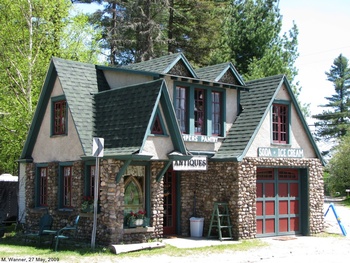 Seven Gables, in Onchiota, was built as a gas station about 1930 by Hayden Tormey. It is now an antique store.
Seven Gables, in Onchiota, was built as a gas station about 1930 by Hayden Tormey. It is now an antique store.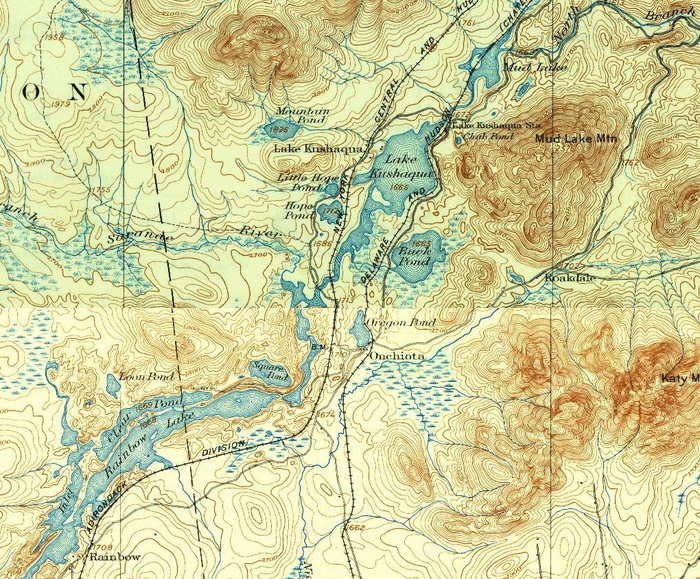 Onchiota
Onchiota
1908 Loon Lake quadrant, above
1904 Saranac quadrant, below
Excerpted from Nathan Brown, "The first Franklinites", Adirondack Daily Enterprise, January 17, 2009
Onchiota was one of the later-settled parts of the Town of Franklin. A mill was built there after the Delaware and Hudson and New York Central railroads came through the town in the late 1880s and early 1890s; both stopped in the hamlet. Most of the men and boys who settled around it worked there, wrote Hayden Tormey in the first volume of "They Told Me So." When the wood ran out, boarding houses sprang up, and wealthy city people came in to hunt and fish. Some stayed and built camps.
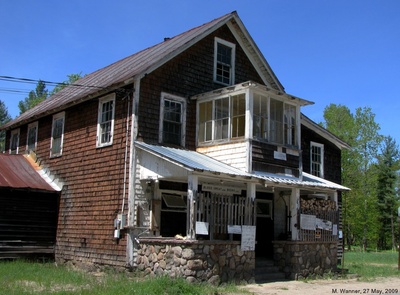 Onchiota store The only non-residential building in Onchiota in the early 20th century was the general store, which had the only telephone. You could catch a train out every half-hour, but a trip to Vermontville or Bloomingdale overland could take a half-day. Onchiota became a bit busier during Prohibition, as the rum-runners loved the back roads there and used to tear down them, shooting it out with pursuing federal agents.
Onchiota store The only non-residential building in Onchiota in the early 20th century was the general store, which had the only telephone. You could catch a train out every half-hour, but a trip to Vermontville or Bloomingdale overland could take a half-day. Onchiota became a bit busier during Prohibition, as the rum-runners loved the back roads there and used to tear down them, shooting it out with pursuing federal agents.
Tormey wrote that Onchiota started to lose its remote character after World War II.
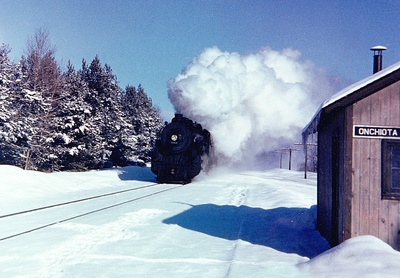 Undated.
Undated.
Courtesy of Doug Vensel Onchiota section of the 1917 Mountain Home Telephone directory. Courtesy of Betsy Minehan."Our general store changed, too; no people, no business," Tormey wrote "What to do, advertise? Yes; our slogan 'Off the beaten path.' Federal help programs came, then the Olympics of 1980. New paved roads replaced our once two-wheel rut roads. Progress..."
Onchiota section of the 1917 Mountain Home Telephone directory. Courtesy of Betsy Minehan."Our general store changed, too; no people, no business," Tormey wrote "What to do, advertise? Yes; our slogan 'Off the beaten path.' Federal help programs came, then the Olympics of 1980. New paved roads replaced our once two-wheel rut roads. Progress..."
The Chateaugay branch of the Delaware and Hudson Railroad, which ran through Franklin, discontinued stopping at its Onchiota and Vermontville stations in 1940, although it continued to stop at Loon Lake until 1946. New York Central ended its passenger service from Lake Clear to Malone in 1957, although some freight service continued into the 1960s. Attempts to bring the railroad back for the Olympics were unsuccessful.
Schools
The earliest records of schooling available are from 1878, Fran Oliver wrote in "They Told Me So." In this year, the town of Franklin had one school, in Vermontville across state Route 3 from where the town garage is today. Seventy-six out of the town's residents between the ages of five and 21 went to school that year; an average of 26 showed up any given day. Later, there would be at least 12 schools, although they weren't all operational at the same time.
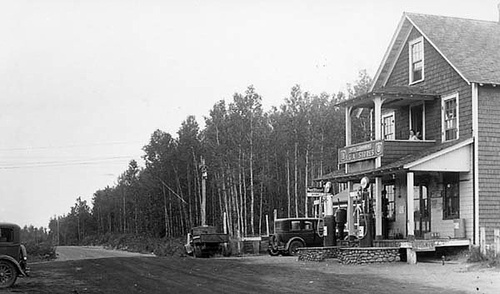 Onchiota IGA, c. 1920
Onchiota IGA, c. 1920
Courtesy of Adrondack ExperienceThese schools only taught through primary grades; parents who wanted a high school education for their children, in the early days, had to pay to send them elsewhere and pay their room and board as well, according to Raymond Tuthill in "They Told Me So."
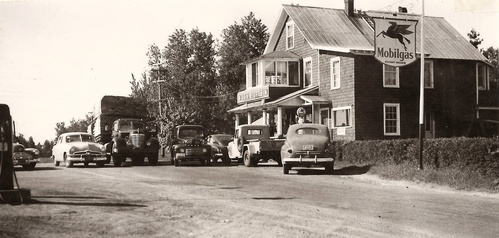 Main Street IGA, c. 1952
Main Street IGA, c. 1952
Courtesy of Tim Mayers
Betty Goff Wilson wrote about her memories of attending primary school in a two-room schoolhouse in Vermontville in the 1950s that is the Franklin town hall today. Grades one through three were in one room, four through six in the other.
 Oregon Pond, Onchiota, 1921
Oregon Pond, Onchiota, 1921
Courtesy of Adrondack Experience"Each day started with a recitation of the Pledge of Allegiance and the Lord's Prayer," Wilson wrote in They Told Me So. "On Monday mornings we each got a new drinking cup and had 'inspection,' which meant the teacher went up and down the aisles checking each student's fingernails, etc."
A cafeteria had recently been added to the school, and Wilson remembers helping the cook set the tables, dish up dessert and arrange condiments on the tables while in sixth grade.
The Sugarbush and Vermontville school districts voted to send their high schoolers to Saranac Lake High School by bus in 1934, and Merrillsville, Loon Lake, Onchiota and Franklin Falls later did the same. Private contractors brought the high school children to and from Saranac Lake until these little districts throughout the town centralized with Saranac Lake in 1968. At the same time, the one-room schoolhouses closed and the younger children started to go to Saranac Lake as well. Some of these buildings were sold to private owners; others fell into disrepair or were destroyed by vandalism or fire.
Plattsburgh Daily Press, April 17, 1899
A $10,000 FIRE.
KINSLEY LUMBER CO'S SAWMILL AT ONCHIOTA DESTROYED.
Defective Smokestack Thought to Have Been the Cause.
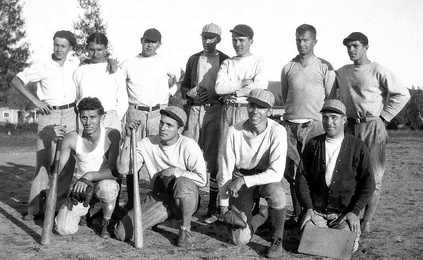 Onchiota Baseball Team, undated.
Onchiota Baseball Team, undated.
Courtesy of Phil FitzpatrickThe Kinsley Lumber Co's mill at Onchiota, or Rainbow, about seven miles from Loon Lake, caught fire from a defective, smokestack last Saturday night, and was burned to the ground. There was a large quantity of lumber piled about the yard, most of which, escaped the flames. The loaded cars were pushed onto a side track, and all but one, a N. Y. C. car, were saved.
An insurance of $10,000 was carried, which will cover the loss, there being $9,000 insurance on the mill and $1,000 on lumber.
The mill was built about four years ago, and two years ago the large store connected with the plant, was burned. Later, a few months ago, an accident happened which imperiled the lives of a number of employees. The cylinder in the large engine in the cellar blew out and tore away the floor above. Luckily no one was injured, however.
S. A. Roake was superintendent of the mill. A. W. Baker, of this place, was formerly connected, with the mill, but has no interest in it at present. Parkhurst & Taylor of this village insured the plant.
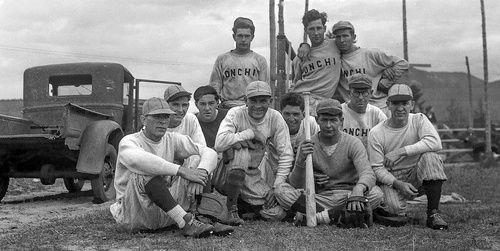 Onchiota Baseball Team, undated.
Onchiota Baseball Team, undated.
Courtesy of Phil FitzgeraldOnchiota is located on both the A. & St. L. and Chateaugay railroads, and in an uninhabited section with no facilities whatever for fighting fire.
There seems to be two theories as to what caused the fire, one being that a spark from a passing locomotive set fire to the roof, and the other that a defective smokestack did the work. The latter cause is most generally accredited.
A series of minor accidents other than the above mentioned have occurred at the mill, from time to time since it was constructed.
Plattsburgh Sentinel and Clinton County Farmer, June 5, 1903
International Paper Co. Send 140 Men to Onchiota.
B. E. Banker, acting for the International Paper Co., yesterday hired eighty men here to fight forest fires and left with them on the afternoon train for Onchiota where they will endeavor to save the timber at that place belonging to the company. The men were provided with shovels, rakes and pails, the tools being furnished by Henry, Wood & Marshall.
At Morrisonville the party was joined by twenty men and at Cadyville by a gang of forty
Plattsburgh Sentinel and Clinton County Farmer, August 12, 1904
Baker Brothers' Lumber Company's Mill at Onchiota Destroyed.
The crew on the late train over the Chateaugay road from Saranac Lake last night brought down the information that the saw mill at Onchiota, owned and operated by the Baker Brothers Lumber Co., was destroyed by fire late yesterday afternoon. They did not know the cause of the fire, and as there is neither telegraph or telephone communication with the place it has been impossible to learn any of the particulars. When the train passed Onchiota the mill was practically burned to the ground. The wind was blowing the flames away from A. W. Baker's residence and from the lumber pile, so that there was no danger of the fire spreading. The mill was valued at $10,000, and the insurance upon it was small.
Hon. E. C. Baker and Ned Baker this morning went to Onchiota to inspect the ruins and make plans concerning the company's lumber and other property there.
Plattsburgh Sentinel, April 24, 1917
MUSHROOM TOWN TO BE DESERTED
 Dock and Coal Company sawmill in Onchiota, undated.
Dock and Coal Company sawmill in Onchiota, undated.
The mill ran a band saw, allowing it to cut larger logs than a circular saw could handle.
Courtesy of Roland Patnode
Onchiota, Sprang Up in Night, Near Its Finish
LUMBER TRACT NEARLY CLEARED
DOCK & COAL COMPANY ERECTED SAW MILL AT PLACE AND CUT MANY MILLION FEET OF LUMBER FROM SURROUNDING COUNTRY
Saranac Lake, April 22—The hamlet of Onchiota, situated about fifteen miles north of Saranac Lake, on the New York Central railroad, is becoming a deserted village. The sawmill of the Dock and Coal company of this city, situated there is to he moved away and as the sawmill represents the only activity, there will be nothing left to lubricate the hamlet. A number of the little houses which are the property of the Dock and Coal company also are offered for sale, to be removed over the railroad to where they will be made into a camp elsewhere in the lumbering district.
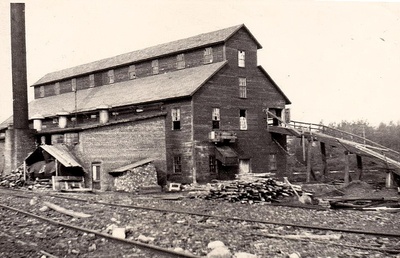 Dock and Coal Company sawmill on Oregon Pond, Onchiota
Dock and Coal Company sawmill on Oregon Pond, Onchiota
It was operated by steam and the fuel was sawdust.
Courtesy of Roland Patnode
Onchiota sprang; up over night when the Dock and Coal company established their hardwood mill there some fifteen years ago. Since that time the company has carried on a very extensive lumbering operation in that region and many million feet of hardwood lumber have been freighted from Onchiota. Last year over five million feet were sawed there.
 Dock and Coal sawmill, undated
Dock and Coal sawmill, undated
Courtesy of Roland Patnode, whose maternal grandparents operated the boarding house in the center distanceFrom thirty to sixty people were regularly employed in the mill, but in the busy season between September and April, there were from 50 to 75 employees. These people with their families made an active little place of Onchiota, but, apart from them, there are only a few dwellers left on the small and scattered farms in the clearings of the neighborhood, as the. Dock and Coal company were the only people to do business there. The lease of the land under which the Dock and Coal company operated is about to expire. The mill is closed down and will soon be dismantled.
Adirondack Record, January 11, 1918
ONCHIOTA MILL GOES TO FLORIDA
The Onchiota mill of the Dock & Coal Co., which has been grinding out hardwood lumber from timber cut in the section around the North Branch of the Saranac River for the last 12 years is being removed to Florida where it will be put in operation at once to work up Florida timber. The mill has been purchased by the Manasota Land & Timber Company, whose lands and forests are in Florida, The headquarters of the company is at Baltimore. The mill will be erected at Venice, Florida.
Frederick J. Seaver, Historical Sketches of Franklin County, Albany, NY: J. B. Lyon Co., 1918, p. 369.
Onchiota or Pine Park is in the western part [of Franklin], and is a small settlement, with store, post-office, two railway stations, a saw mill, and a club house or hotel now in course of construction by the Rainbow Club and Improvement Company. Several thousand young pine trees have been set out here within the past year or two by the same corporation as a step in reforestation, and the state is planting hundreds of thousands of young spruce and pine in the same locality.
Ticonderoga Sentinel, July 8, 1920
Miss Dorothea Calkins arrived home from the Adirondack and Florida School, Onchiota, last week.
Plattsburgh Press-Republican, August 6, 1982
Indian land claims have Onchiota on edge
Correspondent
Kerosene lamps were burning in the old stable 100 yards back of the Onchiota Post Office. The building is rarely used today except for storage.
Bing Tormey, whose official capacity in this small community parallels that of mayor, is actually commissioner of private lands. Bing is working back there.
He is concerned with the Indian land acquisition movement throughout the state. He is attempting to nail down the boundaries of extensive private and public land holdings in the Kushaqua quadrant.
The usual hodge-podge of real estate complexities exists here as in most sections of the North Country. Some land has been leased to the Bureau Brothers logging operation, the White Fathers have retained / some real estate at the site of their former monastery and the state itself holds title to extensive acreage, including the Buck Pond Public Campsite.
Just a mile east of the village, an Indian museum keeps, Onchiota citizens casually alert, to the fact that the Indian nation had strong but vaguely defined claims to the once-beautiful hunting grounds between Onchiota and Loon Lake.
“If it is on paper, it is in this building,” Bing said, scratching a three-day growth of beard. “Everything relating to local Indian traffic is right here in this stable!”
Dick Stickney, who handled the Onchiota publicity before he died several years ago moved a lot of stuff around, Bing said but he never let it out of the building.
Stickney headed up public relations when the Tormey mercantile complex included such titles as “The Snowmobile Capital of the East” and the “Coldest Spot South of Hudson's Bay.”
The old thermometer has been placed under glass for posterity at the general store. At 68 below zero, the mercury shattered the glass tube at the weather station.
Bing's father, Hayden Tormey, back in the 1930s, uncovered a great deal of Indian history relating to Onchiota. He compiled some of it, the legends at least, in a small booklet that is on sale at the Tormey store.
Bing uses an Indian bow to hunt both deer and bear when he feels up to it and his prowess compares favorably with the best sharp- shooting archers in the country.
Indian lore is second nature to him. Whenever a plane crashes or someone is lost in the high peaks, Bing is summoned to lead a search party into the Adirondack wilderness.
Bing denies that he has Tuscarora blood in his veins...”Seneca maybe, but that is pretty well thinned out by now,” he says.
Bing first sensed that the Indian movement was going to pinch Onchiota sooner or later when the Moss Lake colony was moved up to Altona in Clinton County. He knows that the Penobscots in Maine and a couple of other eastern tribes are slicing off some hefty-sized hunks of real estate wherever old treaties are resurrected.
“It's a little upsetting” he says. “On-Chi-Ota” means “very beautiful in Abenaki. Bing says that Onchiota never had a wigwam atmosphere as such but that the mountains and hills surrounding the area all boast Indian translations.
Bing says that copies of a couple –of old treaties supposedly are in the stable out back of the post office. He would like to be prepared if litigation arises out of Indian claims to the land around his home and the homes of his friends.
Bing's roots go very deep in the Kushaqua quadrant. Onchiota as a white man's village was given definition by a boom-era hardwood mill located between the Delaware & Hudson and the New York Central. The mill-foundation is still visible on the edge of Oregon Pond in downtown Onchiota.
The mill employed about 30 men and between families and girlfriends, cooks and bottle washers the town was pretty lively. Bing conducts tours around the premises if he likes you. He once threw a high-level politician out of the store because he referred to the natives as “mildewed muskrats.” He neither confirms nor denies these stories.
The signs around Onchiota bear a light but venomous touch and Bing says he doesn't care for village publicity unless there is a modicum of humor contained in it. “The world is a festering mess as it is,” Bing claims, and he enjoys laughter and fun even though it is extremely rare in these troubled times.
He would like the newspapers to place some emphasis on the Indian problem as it relates to the Adirondacks. “We are not adverse to getting the truth out where it can breath,” he says, “even if it hurts.”
They are literally tearing up the floors of the stable to produce the valuable documents. Ray Fadden who runs the Indian museum down the road is understandably nervous.
The Fadden historical files and materials concerning the Indian tribes of New York State and eastern Canada are considered totally factual and errorless in the documentary sense. He has addressed university and college audiences as well as civic organizations regarding the heritage of his forefathers.
Bing says he won't sleep until the survey depending on the crown documents is complete. “That day may never come,” he says with sadness in his voice.
See also:
External links:



